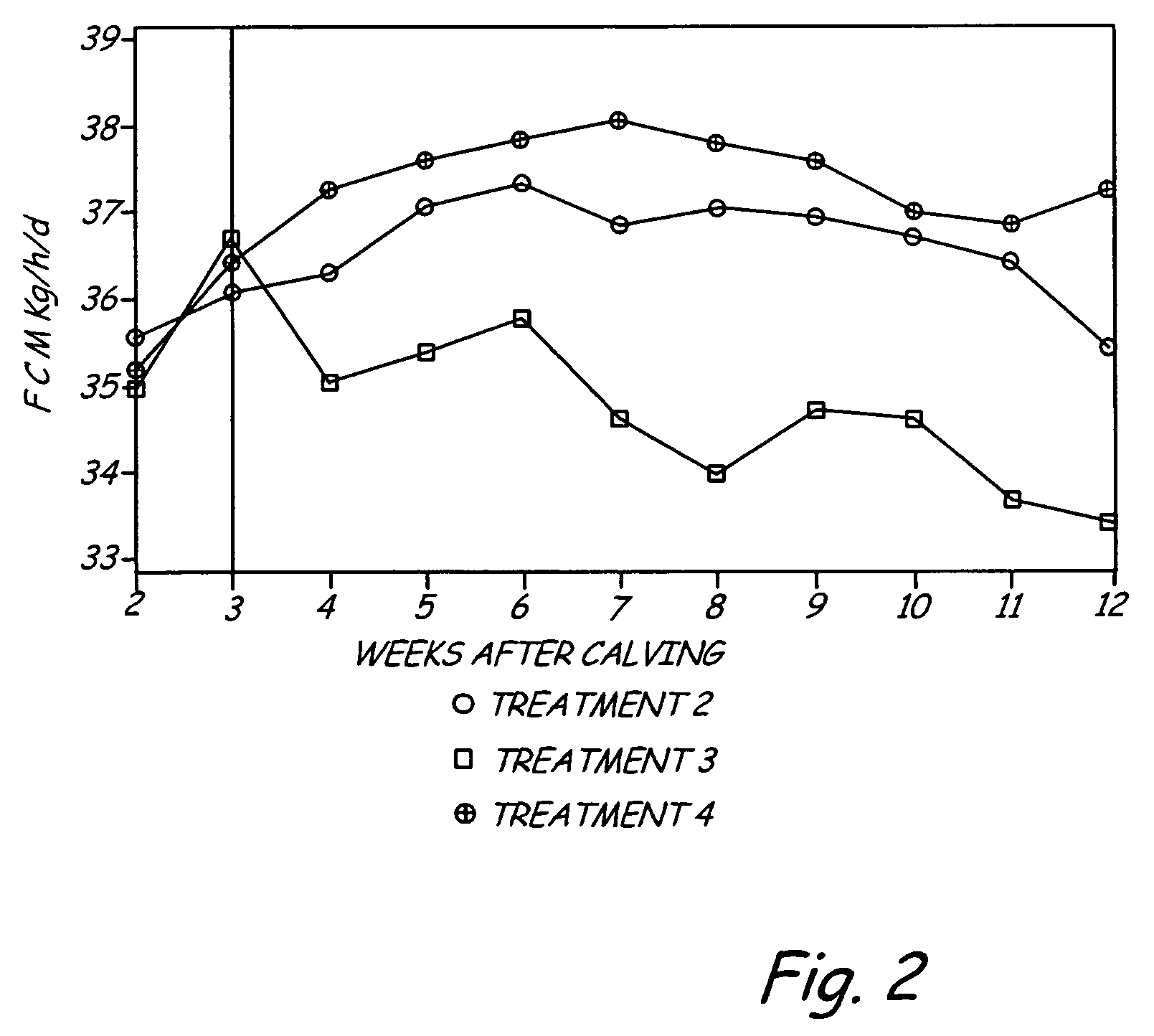Selective feeding of starch to increase milk production in ruminants
a ruminant and starch technology, applied in the field of ruminant feeding methods, can solve the problems of affecting microbial activity, affecting body maintenance, and limited milk secretion in dairy cows, and achieve the effect of improving milk production
- Summary
- Abstract
- Description
- Claims
- Application Information
AI Technical Summary
Benefits of technology
Problems solved by technology
Method used
Image
Examples
example 1
Objective
[0031]To determine the influence of the timing, processing and source of starch feeding on performance of cows in early lactation.
Materials and Methods
[0032]Three weeks before anticipated calving, cows were moved to a close-up dry cow facility and fed a diet of (a dry matter (DM) basis): 32.5% corn silage, 32.5% grass hay and 35% Ration BR1 (Table 3) While cows were in the close-up pens, the following information was collected daily:[0033]a. Number of cows in each pen[0034]b. Total mixed ration (TMR) offered[0035]c. TMR weighed back[0036]d. A blood sample was collected 1 week prior to expected calving.
[0037]Each week individual composites of corn silage were constructed from individual samples collected each day, Monday through Friday. Each daily subsample was added on top of one another in a large container with a tight lid (the corn silage was kept frozen between sampling). On Friday, the corn silage composite was analyzed for DM determination. Furthermore, individual sam...
example 2
[0064]To better determine the dietary levels of starch needed for
[0065]Phase II (weeks 4-12) 12 Holstein cows were subjected to three treatments in one period of feeding. The animals were allowed to adjust to diets for a minimum of two weeks once full treatment feed intake was achieved. During the adjustment phase, feed offerings and refusal were measured daily, but no samples collected. After completion of the adjustment period, feed, milk, urine and feces samples were collected for five days. All animals were fed the assigned diets according to the proportions shown in Table 9. Table 10 shows the composition of the treatments used.
[0066]
TABLE 9Treatments123% of Dry MatterRation A30Ration B43.3Ration C56.7Alfalfa Hay52.542.532.5Silage17.514.210.8
[0067]
TABLE 10Ration% Forage% StarchA707B5717C4327
[0068]Alfalfa hay was from a consistently homogenous supply and the diets were offered three times daily. Forage silage and alfalfa hay were fed as a mix.
[0069]Animals had diets available to...
example 3
[0077]This Example evaluates four levels of dietary starch (10, 18, 26 and 34%), utilizing consistent dietary and experimental conditions, in an attempt to test for non-linear effects on rumen function and digestibility. No attempt was made to add fat to maintain all diets isocaloric, to avoid the interaction from potential ruminal fat effects.
[0078]Four ruminally fistulated steers and four intestinally fistulated steers were housed and fed in a tie stall area.
[0079]Four treatments were applied to each group of four steers in a 4×4 Latin Square design set forth below.
[0080]
RuminallyIntestinallyFistulatedFistulatedSteer #Steer #12341234PeriodTreatment AssignmentI34123412II23412341III41234123IV12341234
[0081]Diets were fed as total mixed rations described in Tables 12 and 13.
[0082]
TABLE 12Treatments1234% of Diet Dry MatterRation A55Ration B55Ration C55Ration D22.555Alfalfa Hay22.522.522.522.5Dual Purpose22.522.522.522.5Silage
[0083]
TABLE 13Treatment% StarchStarch Source110Fine Ground Co...
PUM
 Login to View More
Login to View More Abstract
Description
Claims
Application Information
 Login to View More
Login to View More - R&D
- Intellectual Property
- Life Sciences
- Materials
- Tech Scout
- Unparalleled Data Quality
- Higher Quality Content
- 60% Fewer Hallucinations
Browse by: Latest US Patents, China's latest patents, Technical Efficacy Thesaurus, Application Domain, Technology Topic, Popular Technical Reports.
© 2025 PatSnap. All rights reserved.Legal|Privacy policy|Modern Slavery Act Transparency Statement|Sitemap|About US| Contact US: help@patsnap.com



